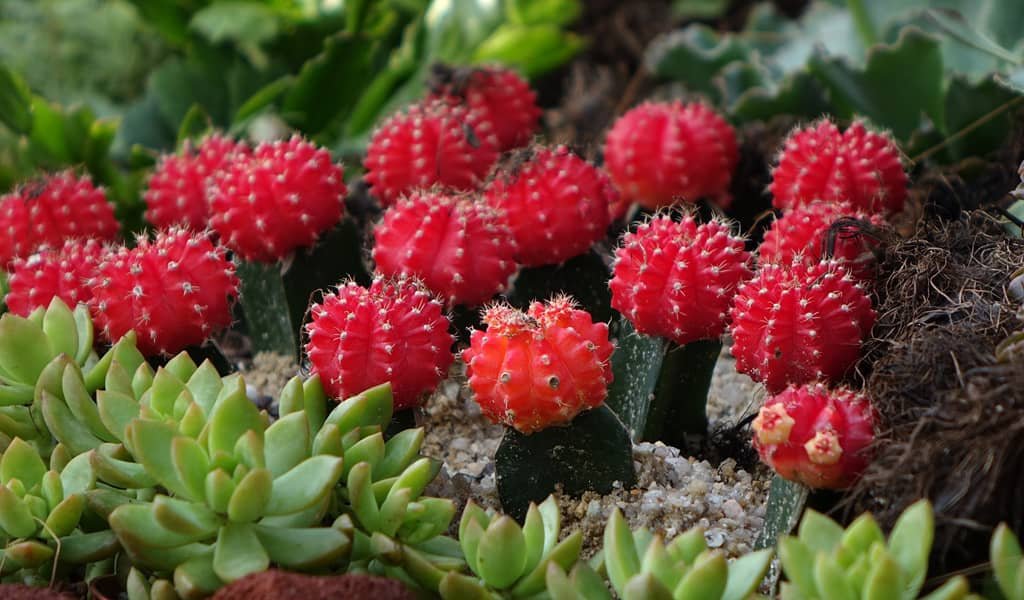The scientific name of the moon cactus is Gymnocalycium mihanovichi which is a well-known species of cactus from South America. A composite new plant was prepared by grafting onto the Hylocerus cactus known as the “Moon Cactus.” This moon cactus is also known as Red Hibotan, Ruby Ball, Red Cap, and Hibotan Cacti. but, Mutants found in this plant due to its complete lack of chlorophyll are yellow, orange, and red in color.
The plant is broad-spherical in shape with a height of 20 cm and a diameter of 3 to 5 cm. and Moon cactus has 4 to 6 gray spines that are delicate, weak, and curved. The flowers of this plant are 4 to 5 cm long, yellow and red in color.
Content summary:
- What is Moon Cactus Plant
- Other names of Moon Cactus
- History of Moon Cactus
- Most Interesting Facts
- Types of Moon Cactus
- Growing Moon Cactus Plant at Home?
- How to Care
- Protect Against Pests and Diseases
- Uses of Moon Cactus
- Related Questions
History
Moon cactus is found in northeastern Argentina and Paraguay at elevations up to 500 m. The plant was first described by Robert Louis August Maximilian Gurke in 1905. It was added to the genus Gymnocalycium in 1922 by Nathaniel Lord Britton and Joseph Nelson Rose. then This species was discovered by Alberto Wojtek Frick in 1903.
Moon Cactus Overview
- Botanical Name: Gymnocalycium mihanovichii
- Common Name: Red Hibotan, Ruby Ball, Red Cap, and Hibotan Cacti
- Plant Type: Herbaceous perennial
- Bloom Time: Varies; usually, summer
- Soil Type: Rich, fast-draining cactus mix
- Soil pH: Acidic t neutral (5.5-7.0)
- Sun Exposure: Partial, shade
- Mature Size: Depends on rootstock and varies
- Hardiness Zones: 10-11 (USDA)
- Plant Flowers Color: Yellowish-green (indistinct)
- Native Area: South America
Types of Moon Cactus
Different types of moon cactus are mostly the same, except the flowers vary in color. The flowers of this plant are red, purple, white, and yellow. These flowers appear in summer. Different types of this plant have a uniformly green lower part and other upper parts.
How to Grow & Care
For the moon cactus to grow well, we need to provide it with a good environment that has temperatures between 50 and 60 degrees Fahrenheit during the day. In addition, it prefers a shady location where it receives diffused light. accordingly, Provide water when water is needed.
Caring for a moon cactus is not too difficult. Before watering the Moon cactus, the top surface should be certainly dry and not exposed to excessive water and dampness, or it may cause root rot. Fertilize the soil of this plant to get good results.
Light
The upper balls of the moon cactus are more shade tolerant, while the lower green part needs direct light for photosynthesis. So This plant does best in an area where it gets good bright light. Morning sunlight helps the plant to grow more. The upper part of this plant does not need much light. Too much light will burn it. The best location for this plant is where it receives sunlight for a few hours and bright but indirect light for the rest of the time.
Soil
Moon cactus plants prefer rich soil with a low pH ideal. So Sandy and loose soil is more suitable for this plant. To create a good ground for this plant, you can mix potting with horticultural sand to create desert-like conditions and grow it with high-quality soil.
Water
Before watering the moon cactus, be sure to give it plenty of water when the top surface is dry. Overwatering will rot the roots of this plant. These plants require frequent watering during summer, but watering becomes unnecessary during winter months. A new young plant needs more water when it is planted.
Fertilizer
If you fertilize your moon cactus plant, use a succulent-specific fertilizer during spring, which is known as the growing season. So This plant prefers poor-quality soil to more fertile. It is necessary to use a low-concentration fertilizer to avoid further damage to these plants.
Temperature and Humidity
Moon cactus is hardy in USDA plant hardiness zones 11 to 12, while some species of this plant are hardy in zones as low as 8 to 9. During the winter, this plant needs temperatures between about 50 and 60 degrees Fahrenheit. This plant must be kept indoors during winter when the temperature drops and cannot tolerate the afternoon heat during summer.
Common Pests and Plant Diseases
Moon Cactus is mostly pest and disease free but can be affected by problems such as mealybugs and spider mites if kept indoors. You can control them with an alcohol-soaked cotton swab, neem oil, or insecticide. A particular disease of this plant is root rot caused by overwatering or poorly draining soil.
Overwintering
If you want to grow moon cactus in winter, it is necessary to bring it indoors because it cannot tolerate cold temperatures below 50 degrees. The ideal temperature during winter is 50 to 60 degrees Fahrenheit, so it needs to be kept indoors.
Uses of Moon Cactus
Moon cactus is commonly sold as gift plants, used to make beautiful window displays, and as houseplants.
Moon Cactus FAQ
[1] How often do you need to water the moon cactus?
Watering the moon cactus every 2-4 weeks is sufficient, but you should check the soil to ensure the plant needs water. Watering is usually required when the topsoil becomes dry.
[2] Does the moon cactus grow big?
Moon cactus is a small plant that is usually about ½ inch (1 cm) short but can grow up to 8 inches (20 cm) tall.
[3] Is the moon cactus poisonous?
This plant is not poisonous to humans and animals.
[4] What is a fact about the moon cactus?
Moon Cactus has a glowing red and yellow mutant. These plants are usually grafted onto cactus and lack chlorophyll. Its flower is traded.

